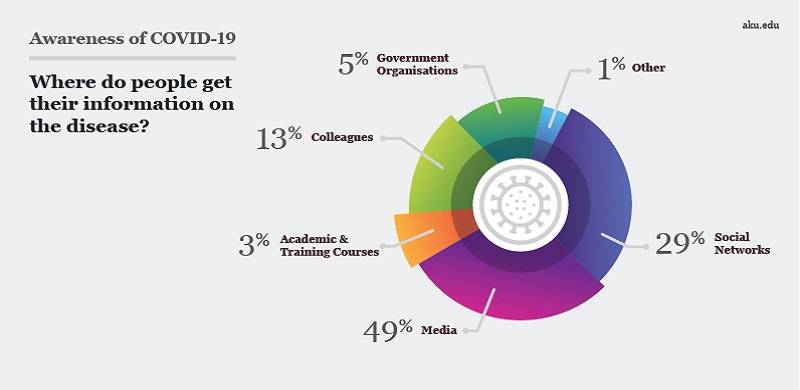
Only half of urban and rural Pakistanis are sufficiently aware of what existing conditions make some individuals more vulnerable to Covid-19, a new study by the Aga Khan University found. While diabetics, smokers and asthmatic individuals are at greater risk from the harmful effects of Covid-19, the AKU study found that the public still lacks this and other basic information on the pandemic.
Researchers surveyed 738 men and women across rural and urban Pakistan to assess their knowledge about symptoms of the Coronavirus, its modes of transmission and how to protect against it.
Professor Zafar Fatmi of AKU’s community health sciences department was quoted as saying:
“Accurate information represents the first step in effectively protecting oneself and one’s loved ones from the disease.” He further noted: “This is especially critical for those living with at-risk groups as it will enable them to take the necessary precautions.”
Around 90% of those surveyed were aware that elderly individuals run a greater risk from Covid-19, nearly half did not about risk factors other than age. These include the prevalance of diabetes, smoking habits and asthma.
Some of the more worrying aspects of the study have to do with rural populations' awareness of basic aspects of the pandemic. For instance, less than 10% of rural people surveyed were aware that living in crowded conditions made them more likely to catch the infection. Within the rural sample, 74% thought that mosquito bites spread Covid-19.
The study found that the public still lacks a proper understanding of the symptoms of the disease. Even though most knew that fever, coughing and breathing difficulties are symptoms of Covid-19, most did not appear to be aware that joint and muscle pains are a symptom too. Moreover, most also do not realize that a large number of people carrying the virus can be asymptomatic themselves, exhibiting no signs of being ill but infecting more vulnerable individuals around them. There is also a large number of people who appear to believe that existing medications can cure Covid-19 – which is not the case.
The study assumed that if a respondent could identify more than 5 out of 10 symptoms of the infectious disease as laid down by the World Health Organization (WHO), this was an adequate understanding. Only 8% of respondents in the study fulfilled this benchmark.
Researchers surveyed 738 men and women across rural and urban Pakistan to assess their knowledge about symptoms of the Coronavirus, its modes of transmission and how to protect against it.
Professor Zafar Fatmi of AKU’s community health sciences department was quoted as saying:
“Accurate information represents the first step in effectively protecting oneself and one’s loved ones from the disease.” He further noted: “This is especially critical for those living with at-risk groups as it will enable them to take the necessary precautions.”
Around 90% of those surveyed were aware that elderly individuals run a greater risk from Covid-19, nearly half did not about risk factors other than age. These include the prevalance of diabetes, smoking habits and asthma.
Some of the more worrying aspects of the study have to do with rural populations' awareness of basic aspects of the pandemic. For instance, less than 10% of rural people surveyed were aware that living in crowded conditions made them more likely to catch the infection. Within the rural sample, 74% thought that mosquito bites spread Covid-19.
The study found that the public still lacks a proper understanding of the symptoms of the disease. Even though most knew that fever, coughing and breathing difficulties are symptoms of Covid-19, most did not appear to be aware that joint and muscle pains are a symptom too. Moreover, most also do not realize that a large number of people carrying the virus can be asymptomatic themselves, exhibiting no signs of being ill but infecting more vulnerable individuals around them. There is also a large number of people who appear to believe that existing medications can cure Covid-19 – which is not the case.
The study assumed that if a respondent could identify more than 5 out of 10 symptoms of the infectious disease as laid down by the World Health Organization (WHO), this was an adequate understanding. Only 8% of respondents in the study fulfilled this benchmark.
